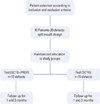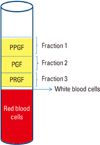1. Keceli HG, Sengun D, Berberoglu A, Karabulut E. Use of platelet gel with connective tissue grafts for root coverage: a randomized-controlled trial. J Clin Periodontol. 2008. 35:255–262.

2. Kassab MM, Cohen RE. The etiology and prevalence of gingival recession. J Am Dent Assoc. 2003. 134:220–225.

3. Lindhe J, karring T, Lang NP. Clinical periodontology and implant dentistry. 2003. 4rd ed. Oxford: Blackwell.
4. Rees JS, Addy M. A cross-sectional study of dentine hypersensitivity. J Clin Periodontol. 2002. 29:997–1003.

5. Oliver RC, Brown LJ, Loe H. Periodontal diseases in the United States population. J Periodontol. 1998. 69:269–278.

6. Grupe HE, Warren RF. Repair of gingival defects by a sliding flap operation. J Periodontol. 1956. 27:92–95.

7. Harvey PM. Management of advanced periodontitis. I. Preliminary report of a method of surgical reconstruction. N Z Dent J. 1965. 61:180–187.
8. Sullivan HC, Atkins JH. Free autogenous gingival grafts. 3. Utilization of grafts in the treatment of gingival recession. Periodontics. 1968. 6:152–160.
9. Miller PD Jr. Root coverage using a free soft tissue autograft following citric acid application. Part 1: Technique. Int J Periodontics Restorative Dent. 1982. 2:65–70.
10. Langer B, Langer L. Subepithelial connective tissue graft technique for root coverage. J Periodontol. 1985. 56:715–720.

11. Wennström JL, Zucchelli G. Increased gingival dimensions. A significant factor for successful outcome of root coverage procedures? A 2-year prospective clinical study. J Clin Periodontol. 1996. 23:770–777.

12. Paolantonio M. Treatment of gingival recessions by combined periodontal regenerative technique, guided tissue regeneration, and subpedicle connective tissue graft. A comparative clinical study. J Periodontol. 2002. 73:53–62.

13. Tozum TF, Keceli HG, Guncu GN, Hatipoglu H, Sengun D. Treatment of gingival recession: comparison of two techniques of subepithelial connective tissue graft. J Periodontol. 2005. 76:1842–1848.

14. Lekovic V, Camargo PM, Weinlaender M, Vasilic N, Kenney EB. Comparison of platelet-rich plasma, bovine porous bone mineral, and guided tissue regeneration versus platelet-rich plasma and bovine porous bone mineral in the treatment of intrabony defects: a reentry study. J Periodontol. 2002. 73:198–205.

15. Maloney JP, Silliman CC, Ambruso DR, Wang J, Tuder RM, Voelkel NF. In vitro release of vascular endothelial growth factor during platelet aggregation. Am J Physiol. 1998. 275(3 Pt 2):H1054–H1061.

16. Anitua E, Andia I. PRGF (platelet rich in growth factors). Dent Dialog. 2004. 3:31–39.
17. Wartiovaara U, Salven P, Mikkola H, Lassila R, Kaukonen J, Joukov V, et al. Peripheral blood platelets express VEGF-C and VEGF which are released during platelet activation. Thromb Haemost. 1998. 80:171–175.

18. Marx RE, Carlson ER, Eichstaedt RM, Schimmele SR, Strauss JE, Georgeff KR. Platelet-rich plasma: Growth factor enhancement for bone grafts. Oral Surg Oral Med Oral Pathol Oral Radiol Endod. 1998. 85:638–646.
19. Anitua E. Plasma rich in growth factors: preliminary results of use in the preparation of future sites for implants. Int J Oral Maxillofac Implants. 1999. 14:529–535.
20. Kassolis JD, Rosen PS, Reynolds MA. Alveolar ridge and sinus augmentation utilizing platelet-rich plasma in combination with freeze-dried bone allograft: case series. J Periodontol. 2000. 71:1654–1661.

21. Zechner W, Tangl S, Tepper G, Furst G, Bernhart T, Haas R, et al. Influence of platelet-rich plasma on osseous healing of dental implants: a histologic and histomorphometric study in minipigs. Int J Oral Maxillofac Implants. 2003. 18:15–22.
22. Huang LH, Neiva RE, Soehren SE, Giannobile WV, Wang HL. The effect of platelet-rich plasma on the coronally advanced flap root coverage procedure: a pilot human trial. J Periodontol. 2005. 76:1768–1777.

23. Lafzi A, Chitsazi MT, Farahani RM, Faramarzi M. Comparative clinical study of coronally advanced flap with and without use of plasma rich in growth factors in the treatment of gingival recession. Am J Dent. 2011. 24:143–147.
24. Miller PD Jr. A classification of marginal tissue recession. Int J Periodontics Restorative Dent. 1985. 5:8–13.
25. Tarnow DP. Semilunar coronally repositioned flap. J Clin Periodontol. 1986. 13:182–185.

26. Löe H. The Gingival Index, the Plaque Index and the Retention Index Systems. J Periodontol. 1967. 38:Suppl:610–Suppl:616.

27. Silness J, Loe H. Periodontal disease in pregnancy. II. Correlation between oral hygiene and periodontal condtion. Acta Odontol Scand. 1964. 22:121–135.

28. Anitua E, Andia I. Preparation technique for PRGF. A new approach for bone regeneration. 2001. Vitoria-Gasteiz: Puesta Al Dia Publicaciones.
29. Jankovic SM, Zoran AM, Vojislav LM, Bozidar DS, Kenney BE. The use of platelet-rich plasma in combination with connective tissue grafts following treatment of gingival recessions. Periodontal Pract Today. 2007. 4:63–71.
30. Ando K, Ito K, Murai S. Improvement of multiple facial gingival recession by non-surgical and supportive periodontal therapy: a case report. J Periodontol. 1999. 70:909–913.

31. Pini Prato G, Pagliaro U, Baldi C, Nieri M, Saletta D, Cairo F, et al. Coronally advanced flap procedure for root coverage. Flap with tension versus flap without tension: a randomized controlled clinical study. J Periodontol. 2000. 71:188–201.

32. Zucchelli G, Clauser C, De Sanctis M, Calandriello M. Mucogingival versus guided tissue regeneration procedures in the treatment of deep recession type defects. J Periodontol. 1998. 69:138–145.

33. Caffesse RG, De LaRosa M, Garza M, Munne-Travers A, Mondragon JC, Weltman R. Citric acid demineralization and subepithelial connective tissue grafts. J Periodontol. 2000. 71:568–572.

34. Cheung WS, Griffin TJ. A comparative study of root coverage with connective tissue and platelet concentrate grafts: 8-month results. J Periodontol. 2004. 75:1678–1687.

35. Karring T, Cumming BR, Oliver RC, Loe H. The origin of granulation tissue and its impact on postoperative results of mucogingival surgery. J Periodontol. 1975. 46:577–585.

36. Lundberg M, Wennstrom JL. Development of gingiva following surgical exposure of a facially positioned unerupted incisor. J Periodontol. 1988. 59:652–655.

37. Del Fabbro M, Bortolin M, Taschieri S, Weinstein R. Is platelet concentrate advantageous for the surgical treatment of periodontal diseases? A systematic review and meta-analysis. J Periodontol. 2011. 82:1100–1111.

38. Griffin TJ, Cheung WS. Guided tissue regeneration-based root coverage with a platelet concentrate graft: a 3-year follow-up case series. J Periodontol. 2009. 80:1192–1199.





 PDF
PDF ePub
ePub Citation
Citation Print
Print








 XML Download
XML Download